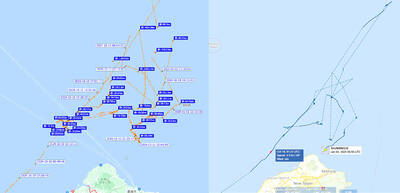Nearly 20,000 air pollution readings a year are labeled invalid due to facility maintenance or malfunctions, the Environmental Protection Administration (EPA) said yesterday, rejecting accusations that it conceals or massages data for big polluters.
The Chinese-language Commonwealth Magazine (天下雜誌) on Tuesday last week reported that nearly two out of three pollution readings last year that exceeded legal standards were concealed in the EPA’s continuous emissions monitoring system.
The number of PM2.5 readings in the system that were labeled invalid increased from 20,640 entries in 2016 to 33,661 in 2017 and 39,456 last year, environmental group Air Clean Taiwan told a news conference yesterday, calling on the Control Yuan and judiciary to investigate whether the EPA was derelict in its duties.
The Legislative Yuan’s Social Welfare and Environmental Hygiene Committee would soon require the EPA to report on the matter, said Democratic Progressive Party Legislator Liu Chien-kuo (劉建國), one of the committee’s two conveners for the current legislative session.
Some air pollution readings are labeled invalid due to regular maintenance on the automatic monitoring devices at the agency’s 77 stations nationwide, EPA Department of Environmental Monitoring and Information Management Deputy Director Wang Yueh-bin (王嶽斌) said.
Last year, the agency recorded 17,314 entries with invalid data, down from 18,853 entries in 2017 and 21,943 in 2016, and lower than Air Clean Taiwan’s figures, because “no data” in entries means that PM2.5 was not tested for and the entries should not be counted, the department said.
The age of some monitoring devices — some are more than 15 years old — can contribute to data problems, Wang said, adding that the agency expects to update devices for measuring PM2.5 concentrations by the end of this year and those for measuring gaseous pollutants by next year.
Even so, available data rates reached 98.05 percent in 2017 and 97.88 percent last year, higher than the national threshold of 75 percent, which is based on US standards, he said.
EPA workers also manually collect air samples from 31 stations nationwide every three days for more careful laboratory testing, he added.
The emissions monitoring system records emissions from 313 exhausts at 108 factories in the cement, steel, waste disposal, petrochemical and paper industries, and the agency plans to tighten regulations governing reporting, Department of Air Quality Protection and Noise Control technical specialist Chen Yueh-shih (陳月詩) said.
All readings are kept in the system, even if some are labeled invalid, Chen said, adding that local environmental bureaus contact factories when they find unusual entries in the system.

A strong continental cold air mass and abundant moisture bringing snow to mountains 3,000m and higher over the past few days are a reminder that more than 60 years ago Taiwan had an outdoor ski resort that gradually disappeared in part due to climate change. On Oct. 24, 2021, the National Development Council posted a series of photographs on Facebook recounting the days when Taiwan had a ski resort on Hehuanshan (合歡山) in Nantou County. More than 60 years ago, when developing a branch of the Central Cross-Island Highway, the government discovered that Hehuanshan, with an elevation of more than 3,100m,

Taiwan’s population last year shrank further and births continued to decline to a yearly low, the Ministry of the Interior announced today. The ministry published the 2024 population demographics statistics, highlighting record lows in births and bringing attention to Taiwan’s aging population. The nation’s population last year stood at 23,400,220, a decrease of 20,222 individuals compared to 2023. Last year, there were 134,856 births, representing a crude birth rate of 5.76 per 1,000 people, a slight decline from 2023’s 135,571 births and 5.81 crude birth rate. This decrease of 715 births resulted in a new record low per the ministry’s data. Since 2016, which saw

SECURITY: To protect the nation’s Internet cables, the navy should use buoys marking waters within 50m of them as a restricted zone, a former navy squadron commander said A Chinese cargo ship repeatedly intruded into Taiwan’s contiguous and sovereign waters for three months before allegedly damaging an undersea Internet cable off Kaohsiung, a Liberty Times (sister paper of the Taipei Times) investigation revealed. Using publicly available information, the Liberty Times was able to reconstruct the Shunxing-39’s movements near Taiwan since Double Ten National Day last year. Taiwanese officials did not respond to the freighter’s intrusions until Friday last week, when the ship, registered in Cameroon and Tanzania, turned off its automatic identification system shortly before damage was inflicted to a key cable linking Taiwan to the rest of

China’s newest Type-076 amphibious assault ship has two strengths and weaknesses, wrote a Taiwanese defense expert, adding that further observations of its capabilities are warranted. Jiang Hsin-biao (江炘杓), an assistant researcher at the National Defense and Security Research, made the comments in a report recently published by the institute about the Chinese Communist Party’s (CCP) military and political development. China christened its new assault ship Sichuan in a ceremony on Dec. 27 last year at Shanghai’s Hudong Shipyard, China’s Xinhua news agency reported. “The vessel, described as the world’s largest amphibious assault ship by the [US think tank] Center for Strategic and International